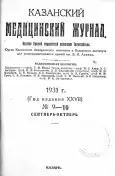К методике культивирования spiroch. pallida
- Авторы: Гельтцер P.P.1,2
-
Учреждения:
- Кр. Микробиологический институт Т.Н.К.З.
- Казанский государств. медицинский институт
- Выпуск: Том 27, № 9-10 (1931)
- Страницы: 951-955
- Тип: Статьи
- URL: https://journals.rcsi.science/kazanmedj/article/view/83764
- DOI: https://doi.org/10.17816/kazmj83764
- ID: 83764
Цитировать
Полный текст
Аннотация
В связи с необходимостью изучения иммунобиологических свойств sp. pallida, приготовления антигенов из этих спирохэт для практических целей перед нами возник вопрос о получении массовых культур sp. pallida. Для получения таких к-p должна быть, с одной стороны, по возможности упрощена методика выращивания, а с другой - применяемые питательные среды не должны содержать кусочков органов, легко распадающихся и переходящих в осадок при центрофугировании. Освобождение культур от этих частиц путем отстаивания и сливания сопряжено с потерей большого количества материала. В этом отношении имело бы большое значение выращивание sp. pallida или с кусочками таких органов, которые не давали бы помутнения среды, или выращивание без добавления кусочков животной ткани. Что касается первой возможности, то, несмотря на прибавление к питательному бульону кусочков таких сравнительно трудно разрыхляющихся органов, как сердце или легкое,— среда все же мутнеет, и таким образом при центрофугировании в осадке накапливаются мельчайшие частицы этих органов. Относительно развития спирохэт нужно сказать, что на такого рода средах, состоящих из одного бульона из конины, pH = 7,6, с прибавлением кусочков мышцы сердца или легкого, к-ры развиваются хорошо, но все асе развитие наступает несколько медленнее и количество спирохэт меньше, чем на обычно нами применяемой среде с кусочками печени быка.
Ключевые слова
Полный текст
Открыть статью на сайте журналаОб авторах
P. P. Гельтцер
Кр. Микробиологический институт Т.Н.К.З.; Казанский государств. медицинский институт
Автор, ответственный за переписку.
Email: info@eco-vector.com
приват-доцент, кафедра микробиологии
Россия, Казань; КазаньСписок литературы
Дополнительные файлы





